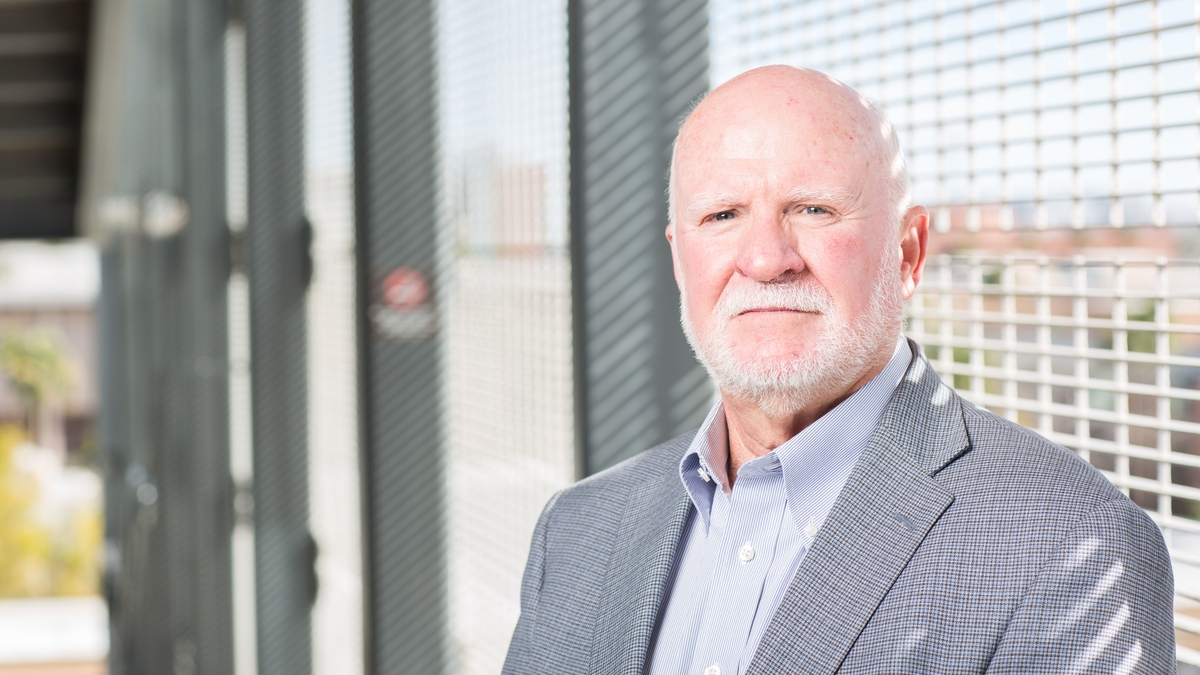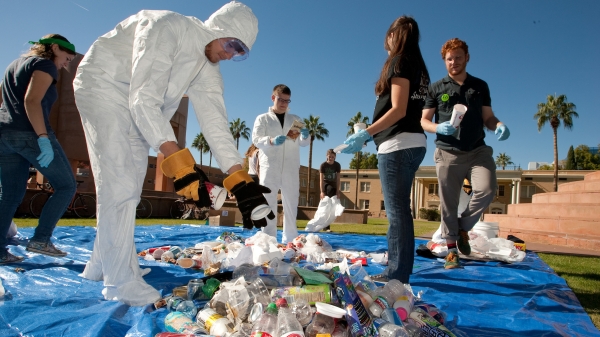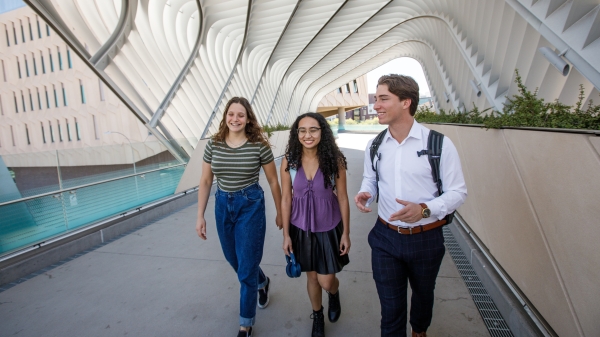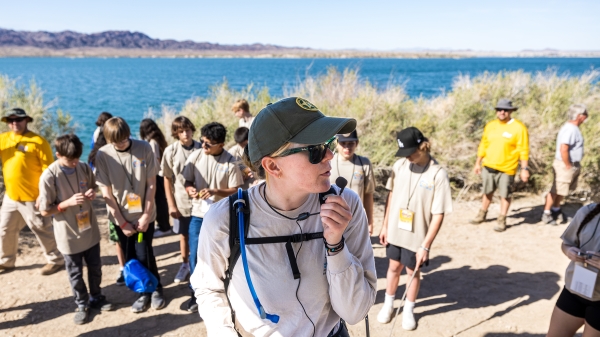Professor’s work sustains global respect
Turner named Regents' Professor for work on climate change and environmental study

B.L. Turner II looks the part of a college professor.
His gray blazer, light blue button-down shirt and neatly manicured mustache and beard combine with his affable manner and slight Texas drawl to put one immediately at ease.
But once he starts talking about his research and the serious nature of its impacts, all that comfort can go out the window.
It doesn’t take long to figure out why Turner (pictured above) is a pioneer in the field of sustainability science or why ASU has recently named him a Regents’ Professor, the highest faculty honor at Arizona State University. His work has changed the way communities and countries are thinking about the environment and climate change.
Turner, the Gilbert F. White Professor of Environment and Society in the School of Geographical Sciences and Urban PlanningThe School of Geographical Sciences and Urban Planning is an academic unit of the College of Liberal Arts and Sciences. and who was instrumental in founding ASU’s interdisciplinary School of Sustainability, was one of the first researchers to use data to better understand how humans affect the landscape and the implications for the environment.
ASU Now spoke to Turner about his recent designation, his groundbreaking work and how human behavior can have devastating impacts if not corrected.
Question: Congratulations on being named Regents’ Professor. What does the honor mean to you?
Answer: Well, I’m honored, quite bluntly. I think all of us do our research because we enjoy the research. When others recognize the quality of it and give nods to you, it’s always deeply appreciated. After all, you don’t enter academia because you’re going to make a lot of money. You’re looking for your own self-interests, truly. I’m very satisfied with what I do and I love what I do. So if you can do what you love doing, people will recognize that what you did is very valuable to you. I enjoy and deeply appreciate the recognition comes along with being a Regents’ Professor.
Q: Your research focuses on how humans affect the landscape, including how the behavior of people in ancient Maya contributed to the collapse of their society. How did that happen?
A: When I entered that question there was an assumption that the Maya had very high populations, very large cities, but the most primitive form of cultivation that you could imagine. This was just not theoretically possible. So we went out to demonstrate that there must have been much more sophisticated forms of feeding themselves. We were able to identify a whole range of activities both through the paleo fossil record but also through the relics on the landscape. Things that the classical archeologist had walked over and had not paid any attention to, we did. We found all sorts of different ways they manipulated their environment and defeated themselves. In the process of doing that we discovered that they transformed so much of their landscape that it had probably had a feedback relationship with climatic desiccation and so their land got drier and drier and drier. That dryness was amplified by the activities they were doing on the land.
Q: One gets the idea that their civilization collapsed or crashed, but you seem to hint at something else.
A: That’s very interesting because there’s no evidence of mass death or collapse; they just depopulated. They got up and moved. The Maya didn’t move just because of the environment — they moved because they decided the costs of combating this environmental change that they produced was too costly. It was better just to go someplace else. So the really interesting question is, “Why didn’t they come back?” Once the desiccation went away and the forest came back within 150 years, the soils would have been good again within 200 to 300 years, and yet no one ever came back. That’s a question very few people have asked. … Why didn’t they come back?
Q: You’ve also spent years researching tropical deforestation. What are the worldwide implications if tropical forests go away?
A: Big. There’s several reasons why tropical deforestation is so critical and worth saving. It’s the most diverse habitat in the world. Most people don’t realize tropical forests are the “lungs of the world.” Those forests suck up an enormous amount of carbon. Not just in the canopy of the trees but in the below-ground biomass, the root systems. If you cut it all down, you release that carbon into the atmosphere but more importantly you no longer have them sucking up the carbon. The combination of that and the biodiversity of the tropic forest make them very special to the world.
Q: You’ve recently focused your research from rural to urban areas with a specific focus on Phoenix. Where does Phoenix stand today in terms of potential problems, and what could be in store if our house isn’t in order?
A: There are some elements in which Phoenix and Arizona are ahead of the curve. One of those is water. As much as we’re paying attention to water, we have taken the appropriate steps. We’re way ahead of California and other states in terms of storage and limited quantities of water. There’s also increasing attention to Phoenix’s urban heat islands, which probably will grow in significance because of climate change. I don’t mean us inducing it here. I mean because of climate change and all projections predict Phoenix will be much warmer here. That means it’s only going to get much warmer here — and that’s going to lead to health problems as well as a series of issues regarding water use. If you look at the longtime projections here, there’s a point where we’ll possibly be reaching mega-droughts. Not the kind of droughts we’ve been experiencing, but a hundred years of substantially lower rainfall. That said, we’re addressing the water problem relatively well but we’ve also got this heat problem that’s interconnected with the water problem and perhaps we haven’t addressed that one quite right yet. … There’s not a lot of empirical work that asks, “What proportion of the Phoenix area can be covered by trees that would help reduce the urban heat island but not at the same time demand so much water?” There are trade-offs. You’re cooling but you’re impacting the amount of water that we have access to. So we’re beginning to grapple with those questions and trying to find out those answers.
Q: Recently the U.S. Senate took two votes and overwhelmingly agreed that “climate change is real and exists” but failed to agree in another vote the root cause. If you were in front of them, what would you have said?
A: If I wanted to be political, I’d say they’re wrong on the second vote. I’d ask, “How can you deny the signs?” So the reality is that a final recognition that climate change is real. It’s not anthropogenic in its origins, it’s a political vote. It’s not based on any science. I’d say 99 percent of the science community absolutely agrees that climate change is not only real — and by the way it’s even higher if you go by the climate scientists — but that the anthropogenic part of that is absolutely huge. To deny that is dumbfounding.
Top photo: B.L. Turner II, by Deanna Dent/ASU Now
More Environment and sustainability

Confusion complicates US recycling efforts
In most major cities and buildings, recycling bins can often be found alongside trash bins in an effort to encourage recycling. But is it working? According to the U.S. Environmental Protection…

ASU empowers students to build a thriving global future
At Arizona State University, leadership has made tremendous efforts to create programs and initiatives aimed at supporting a healthy planet and thriving future for all life — and now, more than ever…

Colorado River becomes an outdoor classroom for these middle school students
Griffin Freburg doesn’t usually look forward to science class. But on a sunny day in March, the eighth grader changed his tune. Concepts that were usually explained in long paragraphs in a textbook…